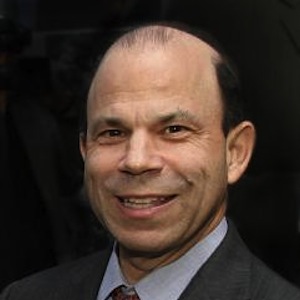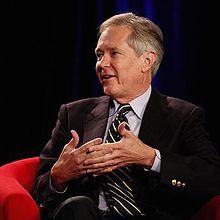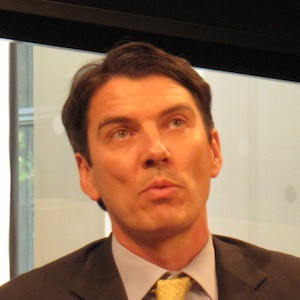Martin Nisenholtz: Martin Nisenholtz here with Jeff Jarvis on March 29 at CUNY.
Jeff, let’s start very simply with the question of your first time. When did you first see digital intersecting with journalism? You go back a long way in journalism, well before the digital era.
Jeff: Personally, I bought my first computer, an Osborne I, which now sits proudly in my office, in 1981, and got onto services like The Source and CompuServe back them. Started to use them for reporting. Then later on, I was the TV critic at TV Guide and used Usenet, where people were doing these amazing things called episode guides.
If I forgot what happened in an episode of Cosby, someone had put it up online. That was a huge revelation, that people would go to that effort to do that. It was the first sense I had of collaboration.
Then I went briefly to Delphi Internet, which Murdoch had bought. It was the first consumer Internet site, or service.
Martin: You say you went there. You went there as an editor?
Jeff: I went there as the chief of content, yes, for one horrible month.
Martin: Scott Kurnit was running that, right?
Jeff: Not yet, no. They were hiring a C.E.O. Murdoch had just bought it. The only way it got you to the Internet was just plain text and a blinking cursor. They weren’t trying to invent a GUI like AOL or like CompuServe. It was a bloody disaster and I got out. Dubbed the bungee boss by one of my employees.
Martin: Didn’t Murdoch put a very senior editor into that.
Jeff: Anthea Disney.
Martin: So you worked for her?
Jeff: No, she came later. She took the head of content job. We invested a huge amount of money in it. It was the first of many Internet failures that he’s had.
Martin: That was pre Internet. I think that was a proprietary service, wasn’t it?
Jeff: It was trying to be, but that was the moment of the Internet. While I was there was the moment that the Mosaic browser was announced. I remember sitting in an office up there, honestly not fully understanding the impact of it yet. But as soon as people showed you the browser, it took your breath away. You said, “Wow, this is simple.”
These things that took Gopher before and hard commands, no one was ever going to do this stuff. It broke out and broke free of the fence of CompuServe or AOL. Now, you could move anywhere. When I escaped Delphi, I went to the Newhouses at “Advance.” They were debating at that moment, just that moment, whether to go with CompuServe, AOL or this new thing, the web.
I certainly wasn’t prescient or the only one who was arguing it, but I was one of those in favor of going to the web. October of 1994 was when the first commercial browser came out. That, I think, is when we saw the true intersection. “New York Times” was on AOL. You had other news. You had “Knight” newspapers and Knight archives on CompuServe and AOL.
Martin: Mercury Center, I believe, was on AOL.
Jeff: That’s right. That’s correct. You saw little snippets of news here and there. Prodigy. But obviously the digital age came in October of 1994, with the web. You think about it now. I always thought that was a decade past. You realize now that it’s 18 years ago, almost. Which sobers us up, about how much time we’ve had to adjust.
Martin: You go to the Newhouses in what role?
Jeff: I went in, working for Jim Willse, who later took over the Star Ledger, to help just start their digital presence.
Martin: In the newspaper division?
Jeff: In the newspaper division, at first, and then also working in the magazine division. Briefly, occasionally with the cable division. And even got to visit the book division before they sold it. We were to start our first services. The first thing I did was create, just to learn how this web thing worked, we hired a design firm, Tom Nicholson and Associates.
We created Rain or Shine. Because I said that television just gives you these weathermen going on forever and ever. All you want is the five day forecast. It was one day with the five day forecast. That was it. That was the first thing we created, just to get some sense of how this thing worked.
Martin: That was rainorshine.com?
Jeff: Rainorshine.com. Later sold to AccuWeather. I sold our first ad to MCI.
Martin: This is now in the newspaper division. My recollection is that NJ.com was one of the first entrants there. Did you play a role in that?
Jeff: Oh, yeah. I was at the heart of starting NJ.com and all the services across the company.
Martin: Talk about that.
Jeff: I worked for Steve Newhouse. The Newhouses are very private, very quiet. They tend to be unsung. Steve Newhouse is very much unsung as a visionary in news online. The thing that Steve taught me, more than anything else, that perhaps corrupted me as I went on, was the importance of community, the importance of providing the opportunity for the community to speak.
We were one of the very first to put up forums on our site. And to revel in the fact that people would get together and talk about their kids’ soccer games and wrestling matches and so on. And their towns. We started putting up news from the paper. At Advance, they decided very early on to do a complete separation.
The online companies were separate companies. They were incorporated separately. They had utterly separate staff. None of the same labor arrangements. There were very strict rules about connections to the paper so that we could have this completely separate thing. If you think back then, this web thing was still an unknown. The Newhouses, at the time, had a lifetime job guarantee, a no economic layoff clause, for their non guild shops.
You weren’t sure you wanted those conditions to accrete to this new world, because it could go away. In ’94 or ’95, the industry still wondered whether this thing was really going to take off. It’s hard to imagine that now. But it was an unsure path. Prodigy wasn’t going to take over the world anymore. How many people were really going to come on?
Were they really going to spend time getting news this way? And so on and so on. I think the earliest newspaper sites were built with that in mind, to be a little unsure. In some cases, they put up the paper. But the Newhouse family’s vision, which at the time was right…It changed, but at the time was very right, was that you didn’t want to just replicate the newspaper online which, as we certainly saw, was going to be the reflex of newspaper editors. PDF it.
Number two, you didn’t want to make the paper use online as value added for advertising and thus, take away any value from this venture online. Three, you wanted to start to create a new relationship with the public, which means that you wanted to have things like forums and chats, which is antithetical to a newsroom’s attitude to the world.
“We will speak to you and please be quiet.” It’s still true, to an extent, today. Much less so. But then it was fairly revolutionary for us to have so much interactivity on the site. That wouldn’t have been possible if it had been another paper. A paper just says, “We’re responsible for what we publish and we don’t want these people saying stupid things.”
We allowed them to say whatever they wanted, smart and stupid.
Martin: There were two approaches, at that point in time. I guess we’re talking about ’95, at this point?
Jeff: ’95, yeah.
Martin: One was to create a brand extension of the paper, in the case of The New York Times it was The New York Times on the web. It was a direct brand extension. The other was to create a new brand. In the case of “The Boston Globe,” it was Boston.com. You guys decided to create NJ.com, which was very much like Boston.com. Why?
Jeff: There was much debate about that and I think there still is today, about the brand question, everywhere. But the belief was, this is something entirely new. It was going to combine multiple newspapers in some of the Newhouse markets. In Michigan, we had eight papers. In Alabama, we had three papers. So you could have a statewide service.
In fact, it started as “New Jersey Online” at NJ.com. One lesson we learned, a fair amount of time in, was that your brand and your URL had to be the same. It was re branded again, to NJ.com, simply. They’ve stuck with that. Where the local online brands…Of course, as you know better than I do in Boston, you had this separation of the two and now, it’s becoming separate in different ways.
We could debate this for a long time. But a lot of newspaper companies did a lot of research to try to understand what was imbued in the newspaper brand and whether that was a benefit in a new digital world or not. You could see that yes, this was a known and trusted brand. You could also see that this is not digital. This is old fart y. This is once a day.
We went with the new brands and the Newhouses. Since I’ve left, I’ve stuck with them.
Martin: Yeah. At that point, you were also making a decision about how much content goes into this new brand and whether it should be a paid or free site. Talk about that discussion inside. Magazines are paid for on the newsstand and through subscriptions. So are newspapers, traditionally. So the Newhouses must have had some debate about that, in their own mind.
Jeff: Again, I have to give a lot of credit to Steve Newhouse and his understanding of this world. It also helped that we had a magazine company next to the newspaper company. As I know, having worked at “Time Inc.,” the economics of magazines and subscription involve a high level of marketing, subscriber acquisition cost.
This idea of, “Let’s just put up a pay wall and people will pay us,” as The New York Times knows, as anyone knows, it’s not as simple as that. It costs money to get money. The notion of subscriber acquisition costs sobered up a magazine publisher looking at online and newspapers, A. B, we had to go for scale, as The New York Times did, as you did at The New York Times.
You had to get to scale before you could do anything. The meter at The New York Times would not be possible today had you not gotten to the scale you’ve gotten to. So scale mattered, trying to get to as many people as you could, mattered. The only revenue you could get, in those days, after Wired invented the banner was banner advertising.
Then we grappled with classified. That was a very difficult decision, obviously, because of the fear of cannibalizing the very high print revenue, which of course then happened anyway. No, I don’t think there was much discussion at the time about pay or not. There was discussion about the content. But Steve Newhouse, my boss, saw the opportunity to reuse content online and knew that its value diminished over time.
He certainly saw the same with magazines as well. I don’t want to speak for him. But he saw that and was very smart about that. That influenced him. I will say that, about the time the crash hit, we were looking at “Epicurious” at Condé Nast.
Martin: You’re talking about the dot com bust?
Jeff: The dot com bust. Advertising had cratered. Here we had this site, Epicurious, which was wonderful. It had all the recipes from “Gourmet” and “Bon Apetit.” Joan Finni and Rochelle Udelle were two brilliant editorial people who worked on those sites. We sat around for hours, trying to think of what premium product could we create on top of the site, to try to get another revenue stream?
The New York Times went through it. Everyone was going through that discussion. Finally, one day, I just said, “How can you beat all the recipes of Gourmet and Bon Apetit? You can’t. That’s where the value is. If you’re going to charge, that’s what you should charge for. We should charge for the crown jewels.” We looked into it, but then advertising started coming back.
There was a fear that it would diminish the audience for that advertising, so they never charged.
Martin: When did you move from the newspaper side over to the magazine side? It was in still the nineties, wasn’t it?
Jeff: After Jim Willse went to the Star Ledger. I was tied at the hip to Steve Newhouse. I officially worked for, eventually what was called Advance.net. Just two people. Steve Newhouse and me. What he did, I helped with. He worked on Condé Nast. He worked on, for a while, Random House. He worked on what later became Bright House Cable.
I would help in some of those things. That was certainly in the ’90s, yes.
Martin: But then, as I recall, Epicurious gets formed, as the first Condé Nast online magazine. At the time, there were these so called “zines.” Steven Johnson had one called “Feed.” There was one called “Suck.” Do you remember them?
Jeff: Absolutely. In fact, I was on the board of what then gobbled those up and became Plastic.com. May it rest in peace. The head was the president of New Century Network. All these memories come flowing back. Yes, I remember the zines very well and some of the first efforts to put magazines online. Here too, the Newhouses went, counter intuitively, to create a new brand.
Very controversial at the time. But Epicurious was able to envelop both Gourmet and Bon Apetit. Very difficult, in a company where the magazines competed with each other. But it was able to start a new brand that was digital. It succeeded.
Martin: At Epicurious?
Jeff: At Epicurious, I think it did. As time went on the magazines demanded and got stronger digital presences, under their own brands. These days, you do see pay walls for The New Yorker and such. We went through the same discussion with Style.com and with “Vogue” and “Glamour” and company. “Concierge” was the travel service, with Condé Nast traveler.
Rochelle Udelle started it, by coming up with the brand of Epicurious.
Martin: Do you remember, at that time, any debates, discussion, inside the company about separate versus integrated business development? In other words, I believe Condé Nast was one of the first and longest standing separate digital operations. Condé Net, it was called. I believe Sarah Chubb ran it.
Jeff: Later on she did, yes.
Martin: OK, so later on. But this was a very gut wrenching thing inside a lot of companies. Because the mainstream brands were losing their control. What was that like inside of Condé Nast?
Jeff: Gut wrenching indeed. But the belief was the same that, if one handed over digital to print editors and publishers, they would try to replicate…
Martin: The innovator’s dilemma.
Jeff: …the models. Come back later. The tablet was where editors and publishers said, “Aha! What the link stole away, the tablet has given back. It’s given back our control of the experience and the relationship with the brand and the business model.” Not really, but that was their hope and belief.
Martin: We’ll get to that in a moment.
Jeff: We have editors who want to create products that the link tears asunder. That alone is difficult. But all the same reasons. Are we going to do what’s appropriate for digital? Will we have enough interactivity? Will we enable the people to talk, share and do things? At Epicurious, Joan Finni helped start something called “Gail’s Recipe Swap.”
Forums. Steve Newhouse was very hard that we had to have forums going in Epicurious. At Condé Nast, there was even more resistance than at a newspaper company. But Gail’s Recipe Swap was a phenomenon. People came in. They shared recipes galore. They demanded that we give them chat. They demanded that we give them a separate forum, so they could create their own content projects.
It was phenomenal to see what happened. People got married. They had meet ups in Chicago. It was one of the earliest goose bump moments, of seeing what can happen if you gave the community a platform to do what it wanted to do.
Martin: I get that. I suppose what I’d like to hear from you is your perspective on the kind of development that took place in that early 2000s era, of these brands versus Internet brands. You had Condé Nast Traveler. What was the Internet brand?
Jeff: Concierge.
Martin: Concierge is built. I’m sure you had a hand in helping to build that. Then “Trip Advisor” comes along and just completely overwhelms it in terms of size, scale, revenue, profit. Trip Advisor is a major public company. Not major public. But it’s a public company today, with significant cash flow. In recipes…
Jeff: All Recipes.
Martin: Exactly. You’ve got this crown jewel of gourmet, meanwhile All Recipes comes and builds this. What is it about the native digital folks, in this arena, particularly in the magazines/vertical content arena, that just seems to overwhelm traditional brands? No matter how smart people are and the best of their intentions. A separate operation, free content, whatever it is. They just never do it.
Jeff: Two answers. Let me first give you an even better example. I got involved in bridal, which was a punch line whenever I said I had to go to a bridal meeting. Condé Nast owns brides. It got “Modern Bride.” It bought the last competitor. You would think it had the entire magazine world of bridal and they owned the bridal world. Along came “The Knot.”
The Knot became the biggest brand in bridal. That was unbelievable. But when you think about it, it’s not so unbelievable because the bridal market flushes out every 18 months, completely. You’re gone. You may come back later, for another wedding, but you’re gone. So it became fairly easy for a brand like The Knot to come along and grab the new brides and that next generation of audience. Online enabled it…
Martin: Why would that be easy? They didn’t have a brand. They didn’t have content.
Jeff: Here’s why. This paradox exists to this day. All those services you mentioned, Trip Advisor, “All Recipes,” The Knot, see themselves not as content factories, but as services. I believe what’s trapped us, in media, is we see ourselves as the makers of content. That traps us in a lot of problems. It traps us in the idea that our content has value and you should pay for our content because we worked hard on it. We hear that all the time.
I’ve never seen a business model built on the word “should,” but I hear it a lot in media. It goes to our editorial ego. “We made this. This is where the value is, we like this and you should pay respect to it.” It’s how we set up our entire operation. I don’t think that’s where the real value is. Content has value. It has considerable value. But it has value more as a tool to other ends.
In the consumer’s mind, the service has greater value to their utility and what they need. From a business perspective, if you serve someone as an individual, not as a mass, you have a better relationship with them, a more valued relationship with them. That is what Google sees clearly. That is why they are in the phone business because these things generate signals about people.
This tells Google where I am, who I am, who I know, where I’m going. I gladly let it do that. So that when I go to Google Now, it tells me how long it’s going to take me to get home today. I never told them where I live and where I work. That’s a relationship with an individual, based on a service. Content plays a role, because content I look at tells Google yet more.
But that’s not the way we look at it in media. In magazines, newspaper companies and TV companies, we think we make valued content and that’s where all our value is intrinsic. We’re stuck there.
Martin: It goes back a very long way, actually. I had this same conversation with Gordon Crovitz, about Yahoo Finance. A service around business news, not a business news content factory, to use your phrase.
Jeff: Exactly. We can’t get out of that. My thinking very lately has been around arguing around this idea of, perhaps we’re not in the content business or should not be in the content business at all. We should rethink of ourselves as being in the service and relationship business. But we’re not built for that. We are built industrially to make content at scale.
It even goes to the business model. The business model of media, and it was a great myth of media, that all readers see all ads, so we charge all advertisers for all readers. That’s what the net, of course, gave up. I don’t know whether you were on it with me, but the horrible audit bureau of circulations net committee, where we debated for hours and hours, “What’s a page view? What’s an impression?”
The thought was, you had to have circulation audits for online sites, because of that old media assumption.
Martin: We were building a company and taking it public during the dot com, to do that. I don’t remember whether you recall that.
Jeff: I do. But it was a fallacious assumption. The advertiser didn’t care about the total audience of the site. All the advertiser cared about was what readers saw their flight of ads. That’s what they wanted audited. This notion of the value of the entire circulation was wrong. We’re still built around that. Look at Comcast. Look out how advertising’s built now.
They go to the big sites, because you have a lot of traffic. You’re not buying that whole site. You’re only buying the pages and the viewers that you can afford. We’re still operating on old media models, in another world.
Martin: We have these so called magazine websites now. Looking back, what would you have done differently? Very good intentions, smart people, as I say.
Jeff: I think Condé Nast is unique, because it had the highest end magazines, competing with few. It had more than one magazine in a category. They could have come along, had Gourmet and Bon Apetit compete with each for preeminence online, with Food Network and these new players that would have come. I don’t think that would have been any better.
Epicurious was a stronger effort, a stronger brand, a stronger product. It thought differently. The notion of having a complete search engine. Joan Fidi had monks literally retyping recipes out of the old magazines, bringing this value online. That was new thinking.
Martin: Could it be, Jeff, that the separate operations weren’t separate enough? That they didn’t have the fire of entrepreneurialism deeply embedded in them? That they were still, even thought they were “separate,” really just flankers of the core businesses? And couldn’t get to the services world, didn’t have the engineering talent, and didn’t have the leadership and DNA to do that?
Jeff: That’s very true. When I started “Entertainment Weekly Magazine,” at Time Inc., back in ’90, we were seen as entrepreneurial because they moved us half a block away. That was the sum and total of the entrepreneurial spirit of the place, that we weren’t in the building. The definition of entrepreneurship, in big media companies. is skewed.
They don’t allow for their own cannibalization. If there’s one big lesson from this entire 18 year saga, it is, of course, the innovator’s dilemma. We didn’t allow ourselves to be disrupted sufficiently from within. Yes, I agree that perhaps they should have been more separate. But I also actually think there’s a biorhythm to this.
There was a point, at the end of my tenure at Advance, when I was going to come here to CUNY to teach, where I didn’t quite say this literally, but I as much as said to my boss, Steve Newhouse, who I respect tremendously, “Fire me.” You get fired very well at Condé Nast, so it would have been a good thing. “Go ahead and kill the division we built. Hold the print staff’s responsible for the digital future. Put some digital people in charge of those things.”
That was too wrenching itself to do by that point. But it’s kind of starting to happen. You’re seeing combinations. In New Orleans, for example, it is now one operation. There is a story arc, better put, to this. If it started out as part of the print operation, it never ever could have been digital. It would have been PDF and value added and not interactive.
Starting separately was very important. You’re right, if they could have really started separate. However, a lot of the value they were getting was the free license or the cheap license to the content, that they were getting from the parent company, from the print publishers.
Martin: Maybe that was a crutch.
Jeff: In some ways, it certainly was. But the other alternative would be to compete with them, which, perhaps, is exactly what they should have done. But less likely to happen. As you go on in time, you come to a time where the separation did become a bit counter productive. If you look at John Payton at Digital First Media, Rafat Ali, founder of Paid Content, mocked Payton’s choice for a company name.
“Digital First? What does that mean?” Payton said, “You’re right, Rafat. That’s a ridiculous name if you’re Paid Content or Google. You’re not digital first, you just are digital. But in our world, I’ve got to make a legacy company digital. I’ve got to get them over that hump.” Alan Rusbridger, at the Guardian, drew a chart of print and digital.
Print coming down, digital going up. He put a green blob in the middle. He said, “We have to get over their green blob,” which they’re still trying to get over. We were trying to figure out that switch to become a truly digital company. If you were going to become a truly digital company at some point, you have to say that the fate of the company, as a digital enterprise, has to be on everybody’s back.
What the separation allowed, and I heard this happen with friends and editors I respected, who would say, “That digital stuff? That’s not my job. My job is to get the paper out. My job is to sell the paper. My job is to still make the paper successful, because the paper still brings in the cash in the company.” That was true. Innovator’s dilemma.
Until you get to the point where you push people off and say, “This is the future. This is where it’s going. We have to push there faster. We are going to become a truly digital company.” Some digital people are going to take over. Some print people are going to learn how to do this in new ways. Everyone is going to see digital as their fate.
That’s where we are today. I don’t think we could have started there.
Martin: Now you leave Condé Nast what year?
Jeff: I leave Advance and Condé Nast, eight years ago now.
Martin: So 2005?
Jeff: I think it’s about that time. When did you buy About.com?
Martin: 2005.
Jeff: Right after that.
Martin: You started consulting for About. At the same time, you brought up this brand called “Buzz Machine,” which was one of the first…Well not.
Jeff: It wasn’t one of the first blogs. The first blogs started about ’99.
Martin: Even before.
Jeff: Oh yeah. That’s right. Buzz Machine was fully a reaction to 9/11. I was in the last path train into the World Trade Center on September 11th. I’d been around blogs. The confession here is that Nick Denton, now head of Gawker, was then heading up a startup called “Moreover.” I had seen it and I chased after him, begging him to allow us to invest in the company from Advance.
We were also doing investments at the time, which was another way we all thought we would learn the new ways and get closer to them. I remember Denton sitting at the law firm, and said, “I have to show you something.” He pulled out a laptop, hooked it all up, which of course took a long time. He showed me Blogger. “Look!” He types in something. He hits a button and there it is.
I said, “BFD.” I didn’t get it. I didn’t understand the importance of blogs. I will fully confess. He showed this to me and I said, “So you published a page.” Clearly, I learned the importance of it. I hung around it. Nick got me to get the Newhouse’s to invest in blogger and save it, one of the many times it needing saving. I was around blogs, but I didn’t do it myself.
After September 11th, I had more to say about the experience. I thought I would do it for a few weeks. I started blogging on Blogger. It took over all available life. It changed my notion of media and thus of my career. It was a critical moment, in my view, of where things go.
Martin: Why?
Jeff: The ding moment for me… Maybe I put too much importance on it. But Nick knew some guys in LA named Ken Lane and Matt Welch, who were earlier bloggers. He said, “Hey, my friend was at the World Trade Center, look what he wrote.” They wrote something about it and linked to it, to me. I linked back to them. I remember Nick lecturing me about the permalink, that I had just linked to the top of their site.
No, you link right to their post. The ding moment there was that I saw a conversation had occurred, in different places at different times. But it was a conversation. That was a lightning bolt of what the link enabled, and how the link changed the very structure of media from a product, a lecture, into a conversation. It really was a changing moment for me.
I kept blogging, was allowed to keep blogging, while I was still employed. Didn’t get into much trouble, and used that to teach me how media was changing.
Here I was, a digital guy, I thought I was on the digital path. I wasn’t nearly enough on the digital path. Blogging taught me a lot. To this day, of course, I keep on learning new ways to look at media.
The biggest challenge between the students and myself, is to get them to question all the assumptions that they assume about media, because of the structure that it has held in the past.
Martin: What’s interesting about this, in some ways, is that you now start blogging, as an employee of Condé Nast, but, you’re not evangelizing that inside? It’s, certainly, not lighting up. It’s not like Condé Nast had legions of bloggers, back then.
Jeff: Don’t forget, I was involved in two different companies.
Martin: It’s almost like, you went native.
Jeff: A little bit. My home was in Jersey City, at Journal Square, at, “The Jersey Journal.” I was on the newspaper side. That’s where my office was. I was also at Condé Nast. They were very different companies, extremely different cultures.
On the newspaper side, we did start blogs. It would be almost 10 years ago, now, I remember, holding a meetup in one of the Oranges of New Jersey, and Debbie Galant came. I said, “Why don’t you all start blogs on NJ.com about your towns?”
Debbie said, “That’s a good idea, Jarvis. But, why the hell would I do it for you?” She started, “Baristanet,” one of the first hyperlocal blogs.
Martin: Still, in a sense, the most successful one.
Jeff: I think so, in a lot of ways. Debbie, meanwhile, has gone to Montclair State, where she’s running a Commons of media in New Jersey. Really, a model, for other hyperlocal bloggers.
Martin: Let’s just pause there, because, I’d like to talk. Why don’t you think her model has really taken off across the country? Is it the peculiarities of Montclair?
Jeff: I think it’s the effort that goes into it. I wrote about this, recently, when another company, Carll Tucker’s company, in Connecticut, ran into financial problems. It was yet another case where hyperlocal gets cooties. “Backfence,” his company, others that have gone by the wayside.
I think the mistake in hyperlocal is that big companies come in, and think they can scale this overnight. Patch comes along, “We can parachute 1,000 recent journalism graduates into 1,000 towns, and put a platform across that, and it will just succeed.” No.
The real lesson from Debbie’s effort, with her partner Liz, at Baristanet, was how local they really were. They were very much part of the town. Also, how much work it took. It’s no way to get rich.
When we did research here, almost three years ago, at CUNY, on new business models for news, we found bloggers scattered across the country, that were bringing in, for towns, similarly sized, $200,000 to $250,000 in revenue. That’s sustainable. It’s sustainable for one person, for two people.
But, it doesn’t immediately scale to 1,000 sites. That’s the problem with hyperlocal. All the efforts to scale it have been to try to have a corporation start many, many sites, all at once. I think, the truth of hyperlocal is that it’s going to be dedicated, local people.
They can use support. In NJ, we’re working out of the NJ News Commons, trying to give them support in areas like training, technology, collaboration, distribution. Services, like, insurance.
Trying to get them so that they can get more support, so that we can encourage more journalists to come in, and cover the towns that they don’t cover anymore. I think, it’s possible to grow hyperlocal, but it’s a really hard slog.
Back to the blogs. We did have blogs at Advance, at the newspaper side. Steve Newhouse was very enthusiastic about the blogs. The papers, of course, were resistant. The New York Times was very resistant.
I had an amazing exchange, at the time, with Bill Keller, when New York Times versus blogs was part of the meme. I urged him to invite bloggers in for bagels. He mocked me, because I had the hubris to speak for all bloggers. It turned into a fascinating email exchange, which I can send you.
There was hostility to blogs, in the early days, among newspapers. But, our separate sites were able to start them, and we did. Eventually, the newspapers came along and started on them.
On the magazine side, yeah, there was some difficulty getting blogs going. I remember an editor, I don’t think I’m telling a tale out of school now, it’s been so many years, but, David Friend, an editor at, “Vanity Fair,” said, “We’re trying to get blogs going. We’re hitting some walls with technology, and, this and that.”
I said, “Well, who do you think should blog, right off the bat?” He said, “James Wolcott.” I said, “Perfect.” There wasn’t a more perfect blogger you could imagine than Wolcott, who would say outrageous things, and have fun doing it, and be smart about it.
I said, “He has a book coming out. Why don’t we just tell everybody that he’s got a book blog, anyway? That fact will help him.” I remember, sitting there with Wolcott, and training him how to blog. This had to be arranged, quietly, so that I could train him.
He would sit there, and I’d open up the blogging platform at the time, I think it was called Movable Type. I said, “Jim, type in a headline.” He’d type in a headline. “Type in your post.” He’d type in a post. “Hit that button.” He hit that button. I said, “Now, go look at it.”
The look on his face, the realization that he had just published to the world, and that entire building underneath him, disappeared. It was phenomenal to watch. I think, we saw that starting to take off.
I think, there was a moment where writers with brands, Tom Friedman at, “The Times,” Jim Wolcott at, Vanity Fair, and so on, and so on, and so on, saw this opportunity to have their direct connection to a public, and they enjoyed it.
It wasn’t just these pajamaed bloggers saying ridiculous things. It was their chance to, also, have a direct relationship with the public, and get in on the fun. I think, that started taking blogs off across the path, including, the magazines. It took awhile. But, I think newspapers were ahead.
Twitter changed it even more. Where Twitter was a way to interact with an audience in a lot more ways, and more productive ways, also, to promote yourself, and do other things. I think we’ve gotten past this prejudice we had for this kind of interaction with the public that really was there in the early days.
Martin: You just mentioned Twitter. Talk about Twitter, and what impact you think it’s having on journalism. Is it a new kind of aggregation? Some people have suggested that it’s a kind of post fragmentation system.
Jeff: I think Twitter, as a platform, provides a great deal of things. One of the complaints we hear about is the echo chamber argument, “We don’t get serendipity. The editors gave us serendipity. Editors would show us what we wouldn’t otherwise see.”
I think Twitter provides that function greatly. Twitter, clearly, provides the function of giving us tips to, not only good stuff, but, also the latest news, and is a way to keep up. Twitter provides promotion for journalists. Twitter provides a way for journalists to do better reporting, and ask people questions, which I see smart journalists doing.
The ideal journalistic view of Twitter is embodied in Andy Carvin, Strategist at National Public Radio, who, of course, tweeted the Arab Spring. He knew people in Indonesia, and Egypt, and he wrote a book, out of CUNY, full disclosure, called, “Distant Witness,” that we just published.
Martin: What was it called? I’m sorry.
Jeff: Distant Witness.
Martin: Distant Witness.
Jeff: That was the first time his work ever turned into a narrative. What Andy did that I think was really important, and the way to look at Twitter is, make it very clear, these were not Twitter revolutions. These were revolutions by brave individuals.
But Twitter and Facebook enabled these individuals to find each other, to know that they existed, to then, organize themselves, to inform themselves. They were very useful tools.
In Tahrir Square, Twitter was, obviously, being used a great deal, but, not to publish to the world. It was being used for communication. But, in that communication, there were incredible amounts of information of value. There were also incredible amounts of disinformation.
Andy came along, as a journalist, and added journalistic value to that flow. That flow that now occurred without the mediator, without media. He, first and foremost, discerned nodes and networks.
He knew this person was really in Egypt, and if that person said that this person was really in Egypt, then we’re going to trust that person more. A journalistic skill. He debunked rumors. He confirmed facts. He got people to help him to translate videos, or, to confirm locations in videos. He added perspective.
He added cautions. If someone said, “This just happened.” He said, “How do you know that? Where did you find that out?” Incredible journalistic value. The role of Twitter is that it enables a flow of information within the community. We, as journalists, should encourage it to go on. It’s cheap for us. It costs us nothing for that flow to go on.
But, the community then needs us to add value to that. We no longer become the creator of all content. We no longer become the gateway to all information. We instead, stand above, apart from, these flows, and these pools of data, and we add value to them.
Martin: I want to touch on that now, because, I think it brings up something that you’ve often talked about, which is this notion of the link economy. We’ll talk about that, as well as, your book, on Google, in a minute.
But, I think, all of us, including, those of us at The Times felt, at a certain point in time, and, I certainly still feel this way, that having an open view of the Web was absolutely beneficial journalistically. It magnifies your voice tremendously.
The business side benefit to that, obviously, is also, to use your initial word, scalability, as well as, now that there are these pay models out there as a base, as you suggested, to convert from.
Because, otherwise you have to do what “The Wall Street Journal” did and build it up one person at a time, which is very expensive.
The question I have, though, is that, speaking for myself, I thought that there would be a much more robust advertising ecosystem, in digital media than there is today. That may be temporary. It may just be a function of right now, as many things are in digital.
But, actually, Jeff, this notion that links have value, it seems to me, has really been, from a business perspective, greatly diminished over the last two years, as, literally, Facebook is selling, I heard this a couple of weeks ago, inventory at nine cents a thousand.
The link to a New York Times page, aside from its potential value as a trigger to subscribe, has gone significantly down as a result of all of this oversupply, and the science of ad tech. That’s where Google comes in.
Can you provide a perspective on that both from a historical perspective, as well as, a current one, in terms of your thinking?
Jeff: My most retweeted bumper sticker line that I’ve ever said was, “Do what you do best, and link it to the rest.” That was a revelation. I think it was about “The New York Times” that I wrote it, actually.
The New York Times does some things magnificently well, and doesn’t need to do other things right now. It’s a national, and becoming an international news brand. Tragically, for New York, it’s less and less a local brand.
The opportunity we have across media is to specialize, which is less expensive, and, one hopes higher value. You get a better relationship. A local paper, elsewhere in this country, can link to The New York Times, and doesn’t need to cover Washington, and should do a good job of covering Cincinnati.
I think that’s really where we need to go, and that’s OK. It provides efficiency, lower cost, greater value to the reader, because The New York Times is going to do a better job than the Cincinnati paper would covering Washington, and so on.
Where’s the economic basis of this? This is where I started exploring the notion of the link economy. Part of the problem with going back to this idea of content is that we think the entire value of the marketplace is intrinsic in content itself.
There’s another creation of value which is the creation of an audience for that content, the links. You touched on another problem. We’re going to come back to this notion of these two values, in one second. But, let’s go off to the real problem, the word we haven’t used yet, is, abundance.
All of media was about controlling the scarcity. All of the media was, thus, about the ability to have pricing power. We lost that when the Internet came along. There’s no shortage of inventory, as we think of advertising.
Martin: Nick Denton, by the way, completely disagrees with that. I can talk to you about why, later. But, we’ve interviewed him, and he has a very, very different perspective on that.
Jeff: Nick Denton said, back in the day, that he was trying to be Steve Newhouse, and he wanted to create as many blogs as Si had magazines. He’s trying to create a scarcity again, which, I think, is possible. I think The New York Times certainly has created a scarcity.
The problem is if you don’t sell out, it’s not really a scarcity. But, by holding the price up, you’ve maintained pricing power, still. But, it’s a tenuous, edge of the cliff kind of effort. You know better than anyone. You can tell me.
But, let me go to Google, now, for a minute. Then, we’ll come back to this notion of the two values. Google didn’t steal business from us in media. Google simply offered advertisers a better deal. Google came along, and if Google had acted like a scarcity controlling media company, it would have said, “Only so many people in a day search on the word, Paris. We will charge what the market will bear for the opportunity to see those people.” They didn’t do that.
What they said instead was, “We’re going to charge on the basis of performance, on clicks.” Thus, Google aligned its interests with the advertisers. Google didn’t manage the scarcity.
Google said, “In fact, what we need is more places where people are talking about Paris, and looking for Paris, so that we can put more ads that are more relevant to people for Paris, so that the ad will perform better, because we don’t get paid if it doesn’t click and it doesn’t perform.”
This is when, and I didn’t get it at first, either, as with many things that you’ve done, Martin. I remember, at a hotel, uptown, an announcement that you, at The New York Times, would be running Google ads. Here I, a Google fan, thought you were nuts. Like I did when you bought About. I was wrong about both.
Because, I thought, “Why are you bringing Google in?” I quickly saw the value of it. You got revenue you wouldn’t otherwise get, from them. You got a piece of their action.
Google, I understood, was creating an abundance. If it could be on The New York Times, travel pages, where the word Paris was enough, that was good for its advertisers. You protected The New York Times, such that an advertiser couldn’t buy through Google instead of through you. You came up with business terms that made it work for both.
What Google did, was align its interests with the advertisers, reduce the risk, or even, take on the risk for the advertisers, in this case, in the case of the early advertising, and rather than control the scarcity, it created an abundance. It offered, thus, the advertisers a better deal.
Rishad Tobaccowala, our mutual friend from Publicis, says that what also happened at that time, was that because, this was an entirely new model, and, because, the big advertisers couldn’t fit into it, Google got an entirely new population of advertisers, smaller advertisers, who otherwise never could afford to advertise in our big, scalable media.
That allowed Google to change the rules, so that by the time the big advertisers came along, the rules had been set in an entirely different way. You now had an advertising marketplace based on abundance. Google set itself up to benefit from that.
We, in media, are still pretty much built on a scarcity based model. We’re also built on a model saying, “You want to be near our content, for our branding, to get to our audience, with these demographics that we have gathered,” and that’s where the value is for the advertiser.
Still true, but becoming more tenuous as we go along, and becoming challenged now, of course, by retargeting, which says, “If I know that you’ve been looking for a hotel in Paris, then that’s more valuable to me than knowing what climate you’re looking at. I can track you around the Web with that.”
Martin: In a direct response context, absolutely. I think that the symmetry has gone wacky on the branding side. But, that’s just putting on my old, OPA hat. I just think that the world has gone nuts.
Jeff: I think, it has, too. I think that becomes the new setting. Now, we go back to the link economy for a moment. We think in the media that the entire value is in the content. I’ve been arguing that there’s also value in the creation of the audience for that content.
You’ve just said to me, “It has limited value, because just more audience, to an unsold out, better brand advertising mechanism, doesn’t necessarily work very well.” That’s true. But, it’s not, necessarily, because there’s no values in the links, it’s because, we don’t, necessarily, know how to get the value out of the links.
When News Corp and Axel Springer go after Google saying, “You stole my story, you stole my soul. You’ve taken all these people from me.” Google says, “No. We sent you a billion people. A billion clicks a month. It’s up to you, publishers, to find the value in that, to create the relationship, and create the value in that.” That’s where the disconnect is.
Martin: Just for a moment, you brought up something that is quite interesting, actually, that Rupert has gone quite hard at Google, over the years, for having stolen his links, and in his mind, his content. But, it’s very easy to simply remove yourself.
Jeff: He did remove, “The Times of London,” for awhile, and then brought it back. He did. I saw a study, two weeks ago, that looked at the market share in circulation, versus market share in Twitter links, of top media brands across half a dozen countries.
The New York Times, and “The Guardian,” have very high Twitter shares. The Times of London, zero, none. It’s out of the conversation. Nobody links to it.
Martin: Does it matter?
Jeff: I think it does, because, he needs to find new customers. I think, for his writers, why do they exist? What’s their reason for being there? To get ahead of the competition, to get people to answer their calls.
A reporter called me, once, from, “The Daily,” and I said, “I’m really busy. Frankly, you’re not big enough to bother with.”
Martin: I’m trying to interview Rupert. I hope to get him by the end of April, to ask him these questions. But, speaking of, The Daily, let’s move over to the tabloids, for just a moment.
Jeff: Let me go over one more thing about the link economy, if I may. The extension of the link economy, I think, is not just that we have a marketplace for the value of links. I think the real extension of it, and I wrote a white paper about this, is that if the content can have attached to it its business model, it can now travel freely.
We’re still stuck in the model of making all the readers come to us. What if we go to the readers? I was about to build a demonstration project about this out of the Tow Knight Center here at CUNY, when, along out of nowhere, Debbie Galant found what I’ve been looking for, the embeddable article. It’s a service called, Repost.Us.
There are four critical things. If an article can be embeddable, like a YouTube video, four things are required. It has to travel with a brand, with the revenue, the advertising, with the analytics, so that you know what’s going on, and with the links back.
They built this. They built it brilliantly. Debbie and others, have used this as a basis to build a network in New Jersey. AFP and, “The Christian Science Monitor,” are using them. Other big media companies are looking at them.
Full disclosure is that they’ve asked me to advise them, because, I’m such a fan of what they’re doing. It’s the extension of the link economy. What it says is that if your content can travel with these things, then, fine, let it fly.
In the early analysis they’ve had with the current clients, they found a couple of important things. One, the overlap in the audience from the creator’s site to the embedder’s site generally is about two percent. When someone embeds your full article, you may get 98 percent incremental audience.
Second important fact. The click through rate from a complete article a complete article with headline, photos, ads, everything, just embedded on my blog, let’s say is five to seven percent. Very high. What it says is, perhaps, Mr. Murdoch, is that no! Google is not stealing your soul, Google isn’t putting up enough content.
Your full article is your best ad. It sends a highly qualified reader who says, “I really like this article. Give me more. I know exactly what I’m going to get.”
When I go there, if you’re smart enough to say, “Aha, this person came from someone who really read that thing in depth and wanted more. Now, I know more about them, now I can serve them better, as an individual.”
Very early days, but to me, that’s the ultimate extension of a link economy. It’s not to say that one should charge for links either way, but that, in the long run, if the New York Times, which now says to the “Huffington Post,” “You’re stealing our soul. You’re summarizing our articles.” But it’s also true the Huffington Post readers want to read New York Times stuff.
It’s a small matter of business negotiation to actually put articles on the Huffington Post with these business conditions attached. That starts to break down the idea of the site. That causes us problems in a world of com score and measurement and brand and all kinds of other complications, but I think we have to think this way.
That, if we can interact with and get to know someone and serve them with relevance, wherever they are, that’s the ultimate extension of the link economy, but we’re barely seeing the beginnings of it to truly understand that. We’re about to embark on some research at CUNY here about that.
Martin: Thank you. I want to end on this more emerging world of mobile, smartphone, tablet environment. You brought up the daily and you kind of anticipated where I was going to go.
The Daily to me was a major media company’s effort to create an entrepreneurial team to actually go out, and really, for the first time, not have access. They could have given them the access to the “New York Post” or maybe they did at a certain point. But in any event, the core mission was to go out and invent content for this new form factor. Basically go build it.
It seems to me they did that. What was your reaction to that effort as an old magazine guy? Also, now looking at it from a very different kind of new media perspective?
Jeff: It wasn’t disruptive at all. The Daily was trying to recreate the world that they knew in a new world. I think it made a bunch of fundamental errors.
Martin: They hired the wrong people?
Jeff: No, it was the wrong assignment going in. I think the idea of let’s create a content property goes back to this idea of content versus service.
Let’s create something that has a brand and experience that’s in a closed world very difficult to link to or link from. It goes back to the idea of a packaged product. An error when the link disaggregates packaged products.
Let’s put a wall around it and a pay wall around it before any value is established, and before you really know what it is. No one can find it and link to it. Let me go back to this content argument because this goes to this.
A paradox of content value that I’ve been thinking about lately, I haven’t written about this yet, is that I could argue that the highest value content is information rich content. What matters to your life.
If you find out that there’s a storm coming, that there’s a sale on…
[crosstalk]
Martin: You have a health problem.
Jeff: Health problem, all that. That’s information rich. The problem, however, is that information of course is easily commodifiable. You can’t and shouldn’t be able to copyright information per say, or own knowledge.
The hot news doctrine be damned. If it’s information, if it’s knowledge, it’s going to be passed around. That’s how society advances is we pass around information and knowledge. It’s extremely difficult to monetize what I would argue is the most valuable content. Information rich.
If you go over to the other side of narrative content. Now I call this without any intent to be pejorative. It’s entertainment. The New York Times avalanche piece was information poor to me.
I’m scared of heights, I don’t ski, I don’t get near avalanches. I have absolutely no utility out of this whatsoever. The only reason for me to spend time with it is because it was entertaining.
In that sense, entertainment can inform and elucidate. I’m not disparaging it in the least. What I’m saying is there are these two different camps of what we think of as content. We’re stuck between the two.
I haven’t figured out how to right this yet. I think that we egotistically think that what we do is create wonderful narratives. Rich, wonderful narratives. Sometimes we do, but that’s a lot harder. There’s a lot of competition.
Competition for people’s time, and it has less intrinsic value. But like a movie, if it’s great, if it’s unique, you may well be able to charge for it.
You’re in the blockbuster economy now. Not everybody’s ego, thinking they can write wonderful narratives, is going to get money. All these students who go out and say, “I’m going to save long form journalism”…which I think is a ridiculous way to say it. Just because it’s long doesn’t make it good.
You have that notion of entertainment. Meanwhile, over here you have what I would call service, which is information rich. We have to look at that as a different business model. News, in theory, should be oriented toward the information side. It’s giving you information you need in your life, a community needs, an individual needs.
That’s, don’t we know now, hard to monetize. Don’t we know that there are new service oriented competitors that come along. Entertainment narrative, whether that is in text or in video or in whatever form it takes, can be valuable, absolutely. But it’s really hard, too, because it’s highly competitive. That’s where we are.
We tend to think that we have both worlds. We did in the past because we controlled the press. Once you take away our power of distribution, then you’re stuck with this idea of saying, “Which way do we go?” I don’t think we’ve decided yet.
The Daily comes along. It says we’re going to be on a tablet. We’re going to be beautiful. We’re going to be like a daily magazine. We’re going to be wonderful. What I’ve heard a lot of people say about it was, “Yeah, it actually is pretty good looking, but the content itself? Just articles.” I think that it was actually stuck badly at that crux of information and entertainment.
Martin: Flipboard would be a much more viable model because it’s more of a service.
Jeff: Kind of, but the problem is, it’s still based on just content. “Let’s put up a lot of content.” Flipboard is the next generation of shovelware. The original generation of shovelware was we, the editors, put up our articles. We’re still doing that. We didn’t re think what the article is. Circa, David Cohen and Ben Huh’s company, is trying to re think the article I think that’s important into assets and paths, as I call it.
Generally, we’re in shovelware mode as individual brands. What Flipboard does is it aggregates the shovelware. You can take content from others. They just came out with a new product. You can aggregate your own, but you’re still taking content and making it look pretty. You’re not changing to the notion of a service.
We’ll see what Marissa Mayer does. Can she go to the idea of a service? I think that’s where she thinks. When we presented our new business models for news at Aspen almost three years ago, Marissa was there for the Knight Commission on information for communities.
She said, “You’re talking, Jarvis, all this stuff about hyperlocal news. I get that. But,” she said, “where I think the world really goes is to a hyperpersonal news stream.” She would include in that, eMail. Not long after that, out came Priority Inbox. She would include in that every stream that comes to you in a day. Google or now Yahoo, in her view, should help you prioritize that and bring order to that.
Martin: Maybe that’s why Zuckerberg referred to the newsfeed as a newspaper in the latest version.
Jeff: Yeah. He originally named it News Feed. I’ll confess the many times that I’ve looked at somebody who had vision at first and pooh poohed it and was wrong. He called news stream. That’s ridiculous. That’s not news. Of course, it’s a news man who would say that.
Then I thought back to one of our earliest experiments to go back to the beginning here at NJ.com where we created a platform for community pages. Community groups to come in and start pages. There are reasons it didn’t work, but at first it was enjoyable to watch.
We had a template. One of the tabs in the template was news. I remember that Ms. Jones ballet school had a page. We looked at it. What was under the news? “The leotards are in.” Well, to those little ballerinas, that was news. To think that we had the monopoly on defining what news is to people, what matters in their lives, is part of the hubris that we’re still living with at our business.
If you instead create a platform for people to share what they know, that’s what the Internet’s really about.















